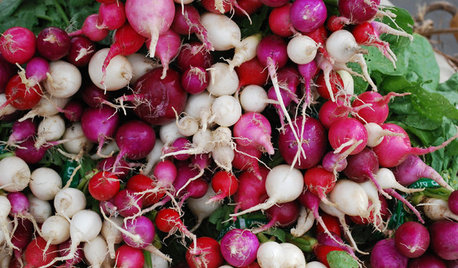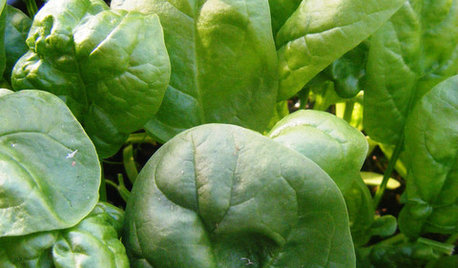How much of your total vegetable consumption are u able to grow?
t-bird
13 years ago
Related Stories

COOL-SEASON CROPSCool-Season Vegetables: How to Grow Potatoes
This ever-popular tuber is a stalwart in spring and fall gardens and a staple in kitchens everywhere
Full Story
COOL-SEASON CROPSCool-Season Vegetables: How to Grow Radishes
Fast growing and bright, these easy-care veggies are great for kids and bring plentiful color to a fall or spring garden
Full Story
COOL-SEASON CROPSCool-Season Vegetables: How to Grow Spinach
Chock-full of antioxidants and iron, spinach is a nutrient-rich addition to your fall or spring garden
Full Story
EDIBLE GARDENSSummer Crop: How to Grow Blueberries
Plant blueberries in spring or fall for garden beauty through three seasons — and a sweet superfood in summer
Full Story
FARM YOUR YARDHow to Grow Vegetables in Containers
Get glorious vegetables and fruits on your patio with a pro’s guidance — including his personal recipe for potting mix
Full Story
EARTH DAYGrow a Beautiful Garden With Ecofriendly Greywater
Reducing home water waste means lower bills and a healthier planet. Here's how to set up a greywater home irrigation system that can help
Full Story
GARDENING GUIDESGreat Design Plant: Grow Blueberries for Their Fruit and More
Eastern gardeners should consider growing blueberry plants for their delicious fruits, bee-friendly spring blooms and brilliant fall foliage
Full Story
EDIBLE GARDENSHouzz Call: What Did You Grow This Summer?
Let’s celebrate the homegrown fruits and vegetables of the season. Post your pictures and tell us about your harvest
Full Story
SUMMER FRUITS AND VEGETABLESSummer Crops: How to Grow Beans
Grow your own beans for amazing variety and healthy, convenient produce all summer
Full Story
EDIBLE GARDENSSummer Crops: How to Grow Squash
Almost foolproof and with cheerful flowers, squash comes in a wide range of varieties to plant in spring
Full StoryMore Discussions








denninmi
bejay9_10
Related Professionals
Saint Louis Park Landscape Architects & Landscape Designers · Winder Landscape Architects & Landscape Designers · Maple Heights Landscape Architects & Landscape Designers · Harvey Landscape Architects & Landscape Designers · Stoughton Landscape Contractors · Wilmington Landscape Contractors · Belvedere Park Landscape Contractors · Bowie Landscape Contractors · Fountain Valley Landscape Contractors · Ronkonkoma Landscape Contractors · San Antonio Landscape Contractors · West Haverstraw Landscape Contractors · Aurora Driveway Installation & Maintenance · Fort Worth Driveway Installation & Maintenance · Leesburg Driveway Installation & Maintenanceoregonwoodsmoke
User
fruitnut Z7 4500ft SW TX
vikingkirken
curt_grow
pnbrown
solidago1
glib
bluebirdie
mauirose
denninmi
pnbrown
keepitlow
t-birdOriginal Author
t-birdOriginal Author
calliope
tcstoehr
sarahkincheloe
pnbrown
curt_grow
glib
t-birdOriginal Author
pnbrown
glib
Donna
vikingkirken
cabrita
nygardener
glib